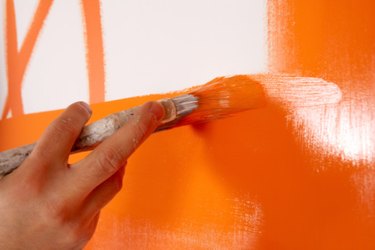Things You'll Need
Large drawing board
Watercolor paper
Masking tape
Gesso
Paint stirrer
Large yogurt container
Large craft brush
Sand paper

Acrylic paints come in a variety of hues, dry quickly and can be used with or without water. Unlike oil paints, clean-up is completed in only a few steps. You do not have to wait for the paint to dry, and acrylics are inexpensive compared to oil paints. Acrylic painting can be done on canvasses or paper prepared with primer. Gesso is a primer made with plaster of paris commonly used to treat canvasses and heavy paper for painting. Preparing paper with primer provides a smooth, nonabsorbent surface to paint on. Masking tape borders ensure the paper dries flat.
Step 1
Place the drawing board on a flat surface. Position the watercolor paper in the center of the board.
Video of the Day
Step 2
Tape the paper to the board on each of the four edges of the paper. Ensure the tape is evenly spaced on each corner, at least 1/2 inch covering the paper. Add two to three additional layers of tape and press to smooth down securely to prevent the gesso from bleeding through.
Step 3
Open the gesso. Gesso comes in large tubs as well as smaller bottles. Depending on how old the gesso is, tubs may need to be stirred for a few minutes with a paint stirrer to integrate the plaster.
Step 4
Pour some of the gesso into a large, clean yogurt container. Add a tablespoon of water. Stir in for a few minutes with a paint stirrer to thin out the gesso. Gesso should be the consistency of yogurt when finished, so add more or less gesso as needed.
Step 5
Coat the large paint brush in the gesso on both sides. Paint on one coat of gesso evenly in one direction (horizontal or vertical) without overlapping. When finished, wash the brush thoroughly under warm water and squeeze it out until the bristles are clear of gesso.
Step 6
Allow the gesso to dry for 20 minutes. Sand the dry gesso down by rubbing the sandpaper in even circles. Brush off the surface. Coat the brush in gesso again, and paint another coat onto the paper, this time in the opposite direction of the first coat. Repeat the process of drying, sanding and priming once or twice more, until none of the watercolor paper shows through and the surface feels smooth and even to touch.
Step 7
Allow all coats of gesso to dry. Begin painting with acrylics. Leave the tape on while you do so, and remove when finished by pulling up gently.
Tip
If you plan on painting a solid background color with acrylic paint, add a little of this color to the gesso/water mixture to save yourself time painting coats later.
If you are working on several paintings, prime all the papers at once.
As you are sanding, run your hand across the surface to feel for any ridges left from the brush bristles.
Warning
Dust from the sanding can be very fine, so wear a face mask to prevent breathing it in.
Video of the Day